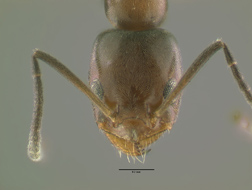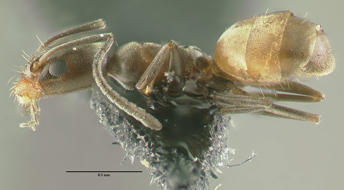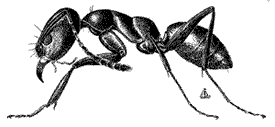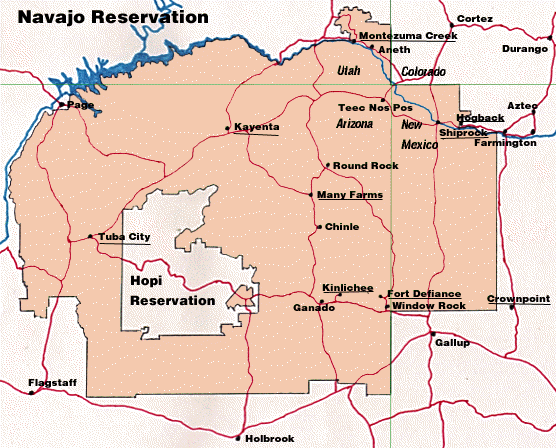- Identification
- Similar in form to Tapinoma but the small petiole, partially hidden by the gaster, is larger in comparison to the almost nonexistent petiolar node of Tapinoma.
- Forelius from the western United States and northern Mexico are part of a species complex that is in need of taxonomic revision. The form we currently assign to Forelius pruinosus, at least in the southwest, likely includes pruinosus and one or more undescribed species. This species group can be distinguished from Forelius mccooki by a lack of standing hairs on the scape.
- Ward (2005) provides his well informed evaluation of the western North American Forelius species:
After examining a large series of Forelius from the United States and northern Mexico I can find no consistent difference in worker head shape: the posterior margin of the head varies continuously from weakly convex through straight to weakly concave. Color is also variable, ranging from dark brown to yellowish-orange. Some nest series contain both light and dark-colored workers. It is possible that the California populations are not conspecific with F. pruinosus (described from Cuba), but these and other western samples seem to grade insensibly into material from farther east and south, including populations in Florida and the West Indies with consistently dark and densely pubescent workers, which correspond to F. pruinosus (s.s.). The complex needs further study but because reliable diagnostic differences have not yet been uncovered I treat F. analis (type locality Chihuahua, Mexico) as a junior synonym of F. pruinosus (syn. nov.).
- Biology
- Forelius pruinosus, senso lato, is an arid, open habitat ant that thrives in hot and dry conditions. Forelius species in the southwestern U.S. are active in the hottest part of the day, foraging and running along trails at temperatures that other co-occurring species cannot tolerate. Foraging does not take place at night, presumably because of cooler temperatures.
- Trunk trails are used by foragers with workers searching for food on the ground and on vegetation. Foragers are general scavengers that will tend aphids and feed from plant nectaries.
- additional biology notes...
- Distribution
- Range
- United States, Mexico, Caribbean and possibly South America. Described from Cuban specimens, the species as currently understood occurs in portions of the northern United States (records exist as far north as Long Island and North Dakota), throughout the southern United States, Cuba, Mexico and possible into South America.
- Navajo Reservation Records
- Species records being processed.
- Additional Notes
- Colonies typically inhabit large polygnynous ground nests. Disorganized small soil craters may also be found at the entrance to some uncovered ground nest entrances. Their predilection for open habitats leads to Forelius pruinosus being a common ant in many anthropogenic and disturbed habitats.
- M.R. Smith (1965), reporting on eastern U.S. ant pests, provides this description of their biology:
The ants seem to prefer open habitats such as fields, meadows, pastures, and entirely bare areas, and will also nest in open woods out of dense and prolonged shade. Nests are constructed in exposed soil or soil under the cover of stones, other objects, and under the bark of logs and stumps. Entrance holes of nests in the soil commonly have crater-shaped mounds of earth surrounding them, but the craters may be imperfectly shaped, or the ground may be more or less bare. Colonies are small to moderate-sized. Males and winged females have been observed in Florida from May into July. Workers are very fond of honeydew, and tend honeydew-excreting insects; they also live on both live and dead insects. The very agile, fast-moving workers form pronounced foraging trails. M. S. Blum, in a letter to the author, wrote that the ants lay down on their foraging trails a methyl-n-amyl ketone substance, which is emitted from the gaster. Workers have been induced to follow artificial trails on which this synthetic chemical has been placed. The odor emitted by live or freshly killed workers has been likened to that of rotton coconuts and is similar to the odor of ants of the genus Tapinoma.
This species is a house pest particularly in the Gulf Coast States. Most frequently the ants invade houses from outdoors, but it is quite likely that they may nest within houses as well. Although workers feed on most of the foods commonly eaten by ants, they seem to show a preference for sweets. - Some of this account is curious, as the species is not known to be much of a house pest today. The reported nesting locations under wood or stones is also interesting. Most of the forms of this ant do not prefer such microsites.
- Etymology
- Descriptive. pruinosus translates to "covered with hoarfrost" and this presumably describes the dense pubescence that covers the workers
- Description
- Original combination - Tapinoma pruinosum - Roger (1863).
- Literature:
- Cuezzo, F. 2000. Revision del Genero Forelius (Hymenoptera: Formicidae: Dolichoderinae). Sociobiology. 35:197-277.
- Mackay, W. P. and E. Mackay. 2002. The ants of New Mexico (Hymenoptera: Formicidae). Edwin Mellen Press, Lewiston, NY.
- Smith, M. R. 1965. House-infesting ants of the eastern United States. Their recognition, biology, and economic importance. United States Department of Agriculture, Technical Bulletin 1326
- Roger, J. 1863. Die neu aufgeführten Gattungen und Arten meines Formiciden-Verzeichnisses nebst Ergänzung einiger früher gegebenen Beschreibungen. Berliner Entomologische Zeitschrift. 7:131-214. PDF
- Ward, P. S. 2005. A synoptic review of the ants of California (Hymenoptera: Formicidae). Zootaxa. 936:1-68.
- A note about these publications. The literature cited here is not meant to be an exhaustive list of papers published about this species.
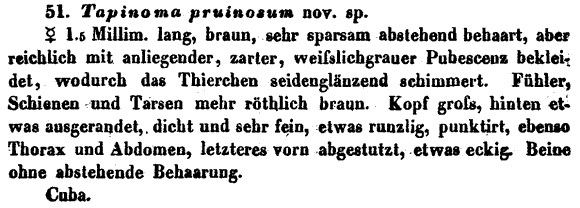
Page authored by David Lubertazzi and Gary Alpert
